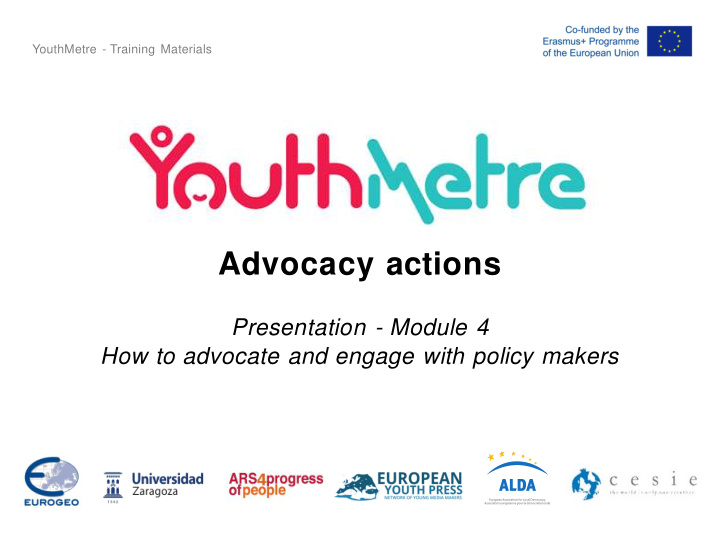



YouthMetre - Training Materials Advocacy actions Presentation - Module 4 How to advocate and engage with policy makers
Advocacy actions (G. Pleyers, N. Karbach 2014) (LSE Report 2013)
Advocacy actions The steps do not have to be taken in sequence as advocacy planning is a cycle , rather than a linear process. You can pick and choose which steps you focus on, depending on your existing level of planning, but you should try to encapsulate all in your action plan.
Step 1: Select your priorities Every advocacy strategy needs to start with a decision on what it is that you want to accomplish. 1. Narrow down your choices Tackling a small number of strong, focused issues will have much greater impact in the short and long term. Addressing a long list of different issues can stretch your capacities and dilute the effectiveness of your work.
Step 1: Select your priorities 2. Define your desired advocacy impact and objectives You need to decide what you want to happen, and by when. Setting your desired ‘impact’ will enable you to be clear about what you are trying to achieve, and will assist you in your planning and design of ‘objectives’ along the way.
Step 1: Select your priorities 3. Objectives Break down the priority/ies to identify your objectives (i.e. the problem/solution tree).
Step 1: Select your priorities
Step 2: Identify your target audience Once you have agreed what you want from your advocacy, the next step is to understand which people and institutions you need to influence to make sure your impact is achieved
Step 2: Identify your target audience • Identifying and analysing stakeholders Conducting a stakeholder analysis will help you understand which institutions and individuals have a ‘stake’ in your issue, as well as their interests, support or opposition (to you and your priorities), influence and importance.
Step 2: Identify your target audience
Step 2: Identify your target audience • Local authorities; • advisers to decision-makers; • influencers (e.g. newspaper editors); • allies and supporters; • opponents; • undecided on the issue (who you may be able to influence).
Step 3: Develop your message(s)
Step 4: Choose your messenger(s) You should choose your messengers strategically and you may wish to have different messengers for different forums or audiences. For example, a well-known celebrity could be very effective at delivering your message to the general public, whereas a scientific expert could bring credibility in a political forum.
Step 5: Identify opportunities and tools There are a number of different mediums you can use to deliver your advocacy messages, for example briefing papers and meetings , websites or press releases .
Step 5: Identify opportunities and tools Three of the most common ways for delivering an advocacy message are: • lobbying • public campaigns • working with the media
Step 5: Identify opportunities and tools Lobbying
Step 5: Identify opportunities and tools Lobbying
Step 5: Identify opportunities and tools Public campaign A campaign is an effort to bring about change. It is not one single action, but a combination of a number of actions , reports and events put together in a sequenced plan. It should be big enough to make a difference, but manageable enough to get short-term results.
Step 5: Identify opportunities and tools Public campaign • Be pro not contra: be the alternative • Creativity: make people dream about what the future can look like + let them participate • Success creates success How to produce support? Be creative: https://www.youtube.com/watch?v=mqA_4fvNx-A
Step 5: Identify opportunities and tools Working with the media
Step 6: Take stock and identify gaps Before putting your advocacy strategy into action you should take careful stock of your advocacy resources. This includes previously established advocacy work, partnerships and alliances; the capacities of staff and other partners; and information and political intelligence available to you.
Step 7: Manage risks No matter how much you plan, there are still a number of risks you could face. For example, when you ‘go public’ with your advocacy strategy there is always the risk that reputations, relationships and partners will be affected. Before you will be able to manage risk in your advocacy strategy, you should spend some time identifying and analysing potential risks.
Step 7: Manage risks • Identifying risks: Conduct research at the start of your advocacy planning to identify potential risks • Analysing risks: Examine the likelihood of a possible threat occurring and the impact that it might have on your activities and success. • Managing risks: consider alternative options if the risk occurs
Step 8: Monitor and evaluate progress and impact Regular monitoring and evaluation will help you to assess how well you are doing against the objectives and impact you have set, and ensure you use your time and resources effectively.
Step 8: Monitor and evaluate progress and impact
YouthMetre - Training Materials www.youthmetre.eu "The European Commission support for the production of this publication does not constitute an endorsement of the contents which reflects the views only of the authors, and the Commission cannot be held responsible for any use which may be made of the information contained therein ”
Recommend
More recommend